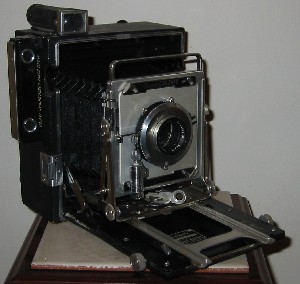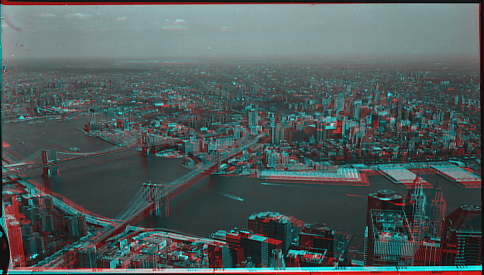Hyperstereo Photographs from the World Trade Center
June 29, 2007
Roscoe, N.Y.
About ten years ago I took my 4×5 Crown Graphic to the outdoor observation deck on the top of the south tower of the World Trade Center in New York City for some experiments in hyperstereo photography.

The 4×5 Crown Graphic was manufactured by Graflex between 1947 and 1970. It is similar to the Speed Graphic except that it doesn't have a focal plane shutter; it's therefore a bit less deep than the Speed Graphic and somewhat lighter. Rather than having a choice between focal plane shutter and lens shutter, the Crown Graphic requires you to use the lens shutter. The lens is a Kodak Ektar with a focal length of 127 mm and a maximum aperture of f/4.5.
On my trip to the WTC observation deck that day I brought along four Grafmatic film holders. Each Grafmatic held six sheets of 4"×5" film. A clever mechanism let you quickly cycle through the six sheets of film. I probably had loaded the film holders with Kodak T-MAX 100, a popular black & white film of that era.
On a previous trip to the observation deck, I had studied the rail around the perimeter of the walkway, and I had built a simple wooden brace that I attached to the camera to allow me to steady it against the rail at a constant angle. My goal was to take photos that I could use for some experiments in hyperstereo photography.
In conventional stereo photography (which dates from 1838), two lens are used that are separated by approximately the distance between our two eyes. In hyperstereo photography, the separation is much greater to accentuate the stereo effect; if your scene isn't moving, you can use the same camera for multiple parallel shots.
On each of the four sides of the observation deck, I took six photographs from equally spaced locations along the rail. The towers were 208 feet wide, so assuming that the observation deck was about 180 feet wide, that would mean the series of six photographs along each side were spaced about 36 feet apart.
When I returned home, I processed the film and made contact prints with four negatives per 8×10 sheet of paper. I'm not sure where the original negatives are, but the long-lost contact prints recently turned up in a box in my closet. Today I scanned them and here they are at 100 and 300 DPI. The 100 DPI files are about 500K and the 300 EPI files are about 5M:
North View (Upper Manhattan): WTCnorth100.png and WTCnorth300.png
North and East Views: WTCnorthAndEast100.png and WTCnorthAndEast300.png
East View (Brooklyn): WTCeast100.png and WTCeast300.png
South View (Upper New York Bay) WTCsouth100.png and WTCsouth300.png
South and West Views: WTCsouthAndWest100.png and WTCsouthAndWest300.png
West View (New Jersey): WTCwest100.png and WTCwest300.png
I hereby release these scans into the public domain for people to do whatever they want with them.
They sure aren't perfect. Some of the negatives are crooked, as commonly happens with contact proofs. I see a lot of dust. Some of the exposures aren't quite the same due to the inconstancy of the lens shutter. Shortly after I made the contact prints, I cut out two squares to make an old-fashioned stereo-card. I've restored the squares for this scan but you can see the cut lines.
Here's one photo from each view, reduced in size:

At the left of the north view is the top of the north tower, which wasn't accessible to the public and which contained televison and radio antennae. The large building approximately in the center of the frame is the Empire State Building.
The east view shows the East River with the Manhattan Bridge on the left and the Brooklyn Bridge closer to the center.
The south view shows Governors Island on the left and the Statue of Liberty on the right; the bridge in the distance is the Verrazano-Narrows.
The west view shows the Hudson River and Jersey City.
Toward the bottom of each frame is some barbed wire used to discourage jumpers. You'll also notice a series of numbers on the outside edge of the building. I believe those numbers are codes for the people who manned the window-washers. The numbers that sometimes appear in a rounded area at the left of the print toward the bottom are from the Grafmatic film holders.
Here's an cyan/red anaglyph I made of the first and fourth east-view images with this rather hard-coded WPF program:

I'm sure it could be improved somewhat by fiddling with the alignment.